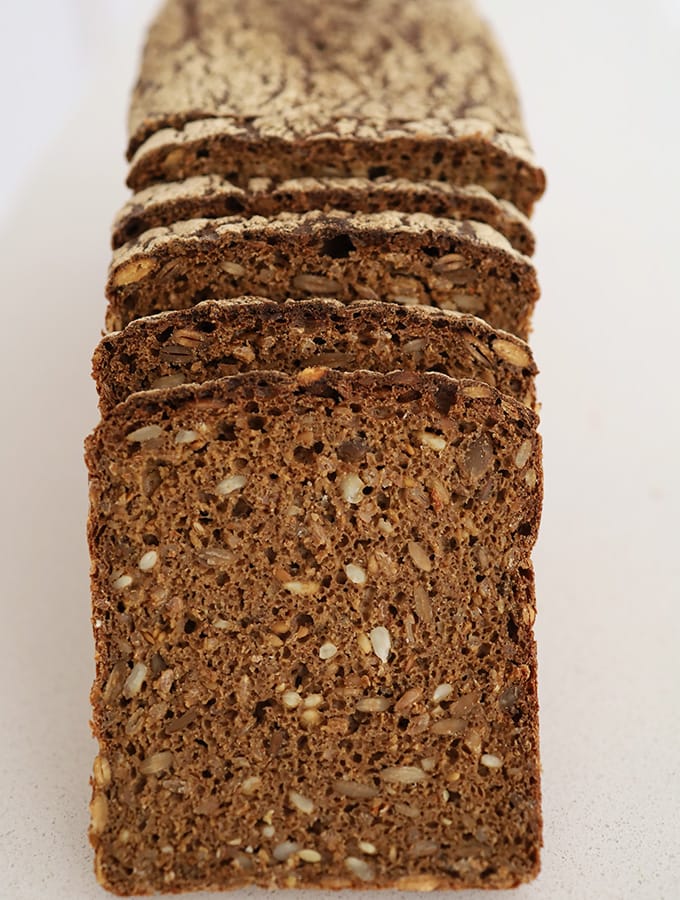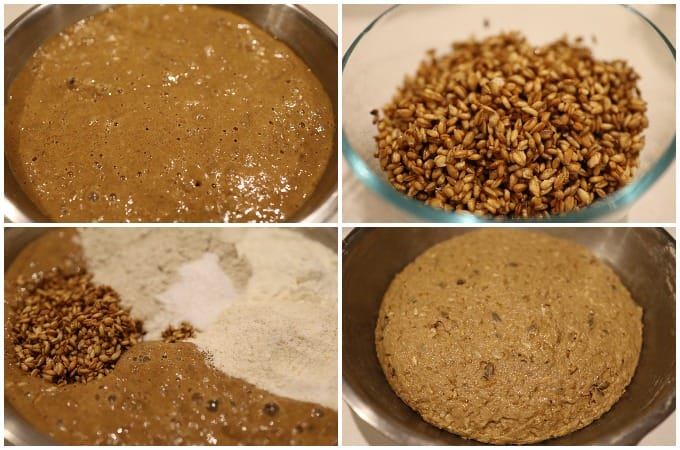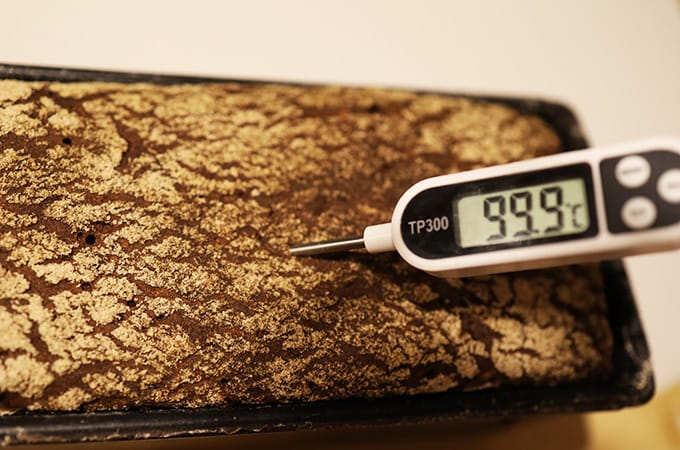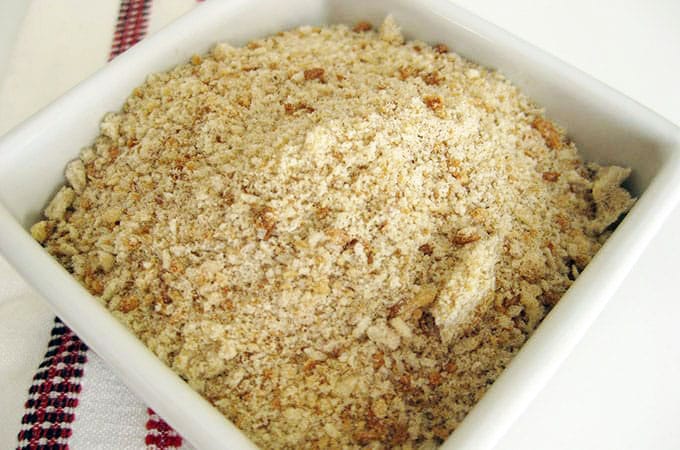Danish Sourdough Rye Bread (Rugbrød)

Northern Europe is famous for its rye bread, as rye grain is the cold climate grain. Danish rye bread, or rugbrød, is one of the best-known types of rye bread from that region. Looking like a brick and full of wholegrain goodness, Danish rye is ideal for making smørrebrød open sandwiches.
Rye bread is one of my favourite bread types. I love the heartiness and the earthy taste of dark rye bread. Dense and filling, rye bread leaves you satisfied after only a slice or two.
What are the ingredients for Danish sourdough Rugbrød?
Danish rugbrød, as its name tells us, is made with rye flour (rug = rye, brød = bread). You also need an active sourdough starter, sunflower seeds, pumpkin seeds, linseeds/flaxseed, kibbled (cracked) rye or rye berries (optional), molasses, beer or water, and salt.
Seeds and rye berries or rye flakes are soaked and added to the wet, sticky fermented dough. The mixture is scraped into a heavy-duty bread baking tin and baked for at least one hour.
Is Danish Rugbrød difficult to make?
Making rugbrød doesn’t require any special kneading or folding techniques like wheat sourdough bread. Rye flour has a lower gluten content than wheat flour, so rye dough is not as elastic and springy as wheat, but rather sticky and has the consistency of thick porridge. There is no need for stretching and folding or kneading the dough. A sturdy mixing spoon is all you need to make this bread.
However, making Danish rye requires time. That’s why I have simplified my danish rye bread recipe so everyone can have a go.
The most difficult part for me is to leave the loaf alone after baking to set for 24 hours or at least overnight! I have the urge to break off a chunk and taste it as it cools down.
How to make Danish Rye Dough

- First, you need to build your levain and soak the seeds. Seeds can be raw or roasted. If you’re using rye berries, these need to be soaked, too. Combine flour, liquid, sourdough stater and seeds in one bowl to simplify the process (top left picture) and make a sponge that ferments for about 8 hours.
- In my recipe, soaked rye berries are optional, so I add them separately. Drain the berries well before adding to the sponge.
- Add the rest of the flours and salt to the sponge to make the final dough (bottom right). You should be able to mix the dough with a sturdy spoon and it should hold the shape when formed into a ball. Cover and let it ferment for one to two hours, depending on the temperature.
- Scrape the dough into a bread tin, sprinkle with flour or seeds and let rise for another hour.
What size bread tin to use?
Traditional Danish rye bread is made with 100% rye flour, however, I add some wheat flour so the loaf is raising slightly more. Plus, if I add soaked cracked rye kernels or berries, listed as optional in my recipe, the loaf rises above the rim. That’s why I don’t use a baking tin with a lid on my pan.
The heavy-duty bread pan I use is 28x10x10 cm or 10.5x4x4 inches. It’s slightly taller than a 9x4x4 Pullman loaf tin.
Light, nonstick baking tins need to be buttered or lined with baking paper before you scrape the dough in to prevent sticking.
Baking Danish Rye Bread

Baking danish rye bread can be slightly challenging as it differs from baking other sourdough loaves. Danish rugbrød is baked at a lower temperature than typical for sourdough and for a longer time. Knocking would not be the best guide for doneness as it doesn’t sound hollow.
The best indicator that the loaf is baked is the internal temperature of the bread. The temperature of a baked rugbrød should reach 98 – 100° C (208 – 212 F).
As I mentioned above, the loaf needs to be wrapped in a tea towel and put in a bread bin once it’s cooled down completely. The crumb needs to set properly before cutting or the bread will end up gummy and look underbaked.
Can you freeze Danish rye?
Absolutely! Cut into thin slices first, then freeze. That way you can take out a few slices at a time. Thin slices of rye bread can be put directly into a toaster.
Help! My Danish rye is rubbery/uncooked in the middle.
The problem could be one of the following three issues:
- The dough hydration was too high – Seeds and flours absorb different amounts of liquid. When the final dough is mixed, it should hold the shape when a ball is formed. The wet dough doesn’t hold the shape and more flour is needed to balance excess liquid and lower hydration. Soaked kibbled rye or rye berries add extra water to the dough, too. If not drained properly, that can push hydration up. Deduct 50-60 ml of the water for the sponge to lower overall hydration.
- The loaf’s required inner temperature wasn’t reached – Rather than relying on the time, the inner temperature of the loaf is a better indicator of doneness. Once the temperature reaches around 100° C, the loaf is baked. How long it takes depends on the oven, the baking tin and the dough hydration.
- The loaf was cut too soon – As mentioned above, once baked, Danish sourdough rye needs to cool down completely and be left to set for at least 12-24 hours. It is tempting to taste it as soon as it’s baked. I have to admit, I’ve done it before. Wrap the loaf and leave it to set for 24 hours.
When you discover a problem with the rubbery or gooey bread, it’s too late to bake it further. The best way to rectify the issue is to toast the slices and make a note in your recipe for next time. Stick with the same amount and type of seeds and flour so you can compare the result.

Danish Sourdough Rye Bread (Rugbrød)
Ingredients
Sponge
- 100 g active sourdough starter 100% hydration
- 700 ml water or dark beer
- 300 g wholemeal rye flour
- 95 g pumpkin seeds (pepitas) roasted
- 95 g sunflower seeds roasted
- 50 g linseeds / flaxseeds
- 40 g molasses or malt extract1
Final Dough
- 200 g wholemeal rye flour
- 100 g wholemeal wheat flour
- 50 g white flour
- 19 g salt
Optional
- 130 g rye flakes / rye berries / /kibbled rye (1 cup) soaked
Instructions
To Make Sponge
- In a large bowl, mix all ingredients for the sponge.
- Cover and let it ferment for about 8 hours at room temperature.
- If using rye flakes or berries, soak them in water for 8 hours, too.
To Make Final Dough
- Add flours, salt and well-drained rye berries (if using) to the fermented sponge2.
- Mix thoroughly using a sturdy spoon. The dough should have a consistency of a very thick porridge.
- Cover the bowl and let the dough rise for 1-2 hours. No stretch and fold needed.
- Scrape the dough into a non-stick heavy-duty or baking paper lined 28x10x10 cm or 10.5x4x4 inch bread pan.
- Smooth out the top and sprinkle with flour or seeds.
- Let the loaf to rise for a further one hour in the baking pan.
- Heat the oven to 200°C (395 F). Bake the loaf for 15 minutes before lowering the temperature to 180°C (355 F) and baking for a further 1-1½ hours. In the last half an hour, check the internal temperature of the loaf by sticking the thermometer tip in the middle. The bread is baked once the temperature reaches 98-100°C (208-212 F).
- Remove the loaf from the pan and leave it to cool completely on a wire rack. Wrap the loaf in a tea towel or place it in a paper or cloth bag. Store the loaf in a bread box for at least 12 hours to set, or even better 24 hours before cutting and enjoying.
Notes
- Molasses adds a touch of sweetness and deep brown colour to the rye bread that is otherwise gray. If you don’t have molasses, substitute with liquid malt extract. The colour will be a bit lighter brown.
- If using soaked rye berries, drain them well before adding them to the sponge. As they will add extra moisture, you can deduct some 50-60 ml of liquid required for the sponge. Also, increase salt to 21g if adding soaked rye berries.



